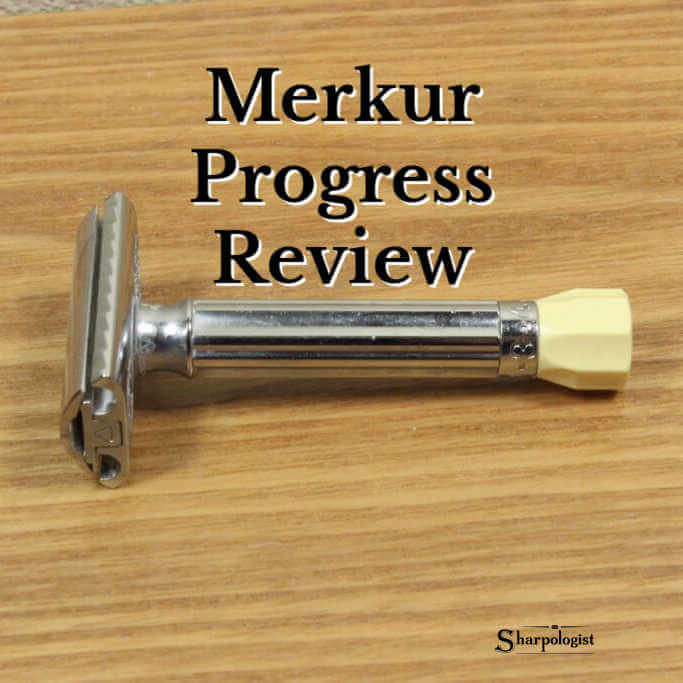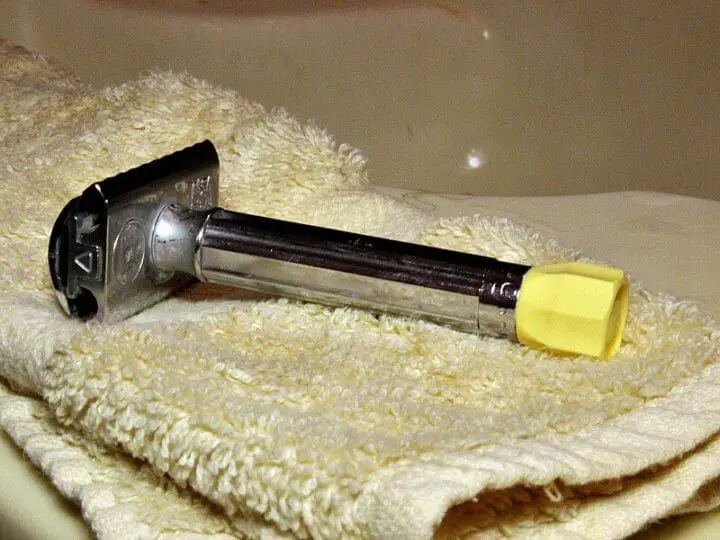
Anyone who knows me or follows Sharpoogist knows I’m a big fan of adjustable double edge razors. But I realized that, while I have mentioned the Merkur Progress a lot, I have never really discussed it in its own article. Here is my Merkur Progress Adjustable Razor review, including specs, pros and cons, what others think of the razor, and my own experiences.
Merkur Progress Background And Specifications
[Note: Amazon, Geni.us, and West Coast Shaving links are affiliate.]
While there are many more options for adjustable double edge razors now, not too many years ago the Merkur Progress was virtually the only adjustable razor available. The Merkur Progress (model 500) was first introduced in 1956, with the long handle version (model 510) appearing in 2011. Here are the basic specs of the two versions:
500
- Overall Weight: 93 g / 3.28 oz
- Razor Length: 88.2 mm / 3.47 in
- Handle Length: 75.8 mm / 2.99 in
- Handle Diameter: 12.4 mm / 0.49 in
510
- Overall Weight: 103 g / 3.63 oz
- Razor Length: 104.6 mm / 4.12 in
- Handle Length: 93.9 mm / 3.70 in
- Handle Diameter: 12.4 mm / 0.49 in
Of course the primary feature of the Merkur Progress is its “adjustability.” Here are the approximate blade gaps for the corresponding dial setting:
- 0.38mm
- 0.56mm
- 0.71mm
- 0.84mm
- 0.94mm
But The Dial Setting…
I say these are approximate gaps because of the way the adjustment mechanism is engineered on the Merkur Progress. The razor head’s “calibration” may not be uniform due to several factors, including the thickness of the blade used and the position of the alignment dot on the razor’s handle. Plus, the razor’s top cap and base plate must be aligned properly to get a broadly accurate setting. So a setting of “3” on one Progress may not be exactly the same as a setting of “3” on another Progress.
Further, due to the way the blade is dramatically bent in the head, the Merkur Progress’ adjustment dial can be turned a full rotation without the head coming off–providing some extremely wide blade gaps for those who may want to turn their shave “up to 11.”
Speaking of that adjustment dial, many users say it is unattractive and looks out of place from the rest of the razor. Several artisans offer after-market adjustment dials, the most famous being “Mer” (with his “Mergress” options. See Bullgoose Shaving and Frugal Shave on Etsy for examples).
What Others Say About The Merkur Progress
There are many Merkur Progress reviews: a simple query on you favorite search engine will return a ton of results. Broadly, most people like the razor’s performance but have issues with the razor’s handle shape and the way the top cap and base plate need to be aligned.
Here’s a small sampling of general opinions on the razor:
“Merkur progress is an excellent razor if you are willing to ignore some of the issues…discussed.”
“This adjustable razor by Merkur is a favorite by a lot of experienced wet shavers because of the versatility it brings to the table. “
“…many prefer the more retro look and lighter weight of the Progress which makes it a nice and nimble razor to use. “
“…the handle has no knurling and as such slipped a lot.”
General Pros
- Adjustable
- Straightforward, classic design (with one quirk of head and base plate alignment)
- Two handle options
General Cons
- Slippery handle
- A “correct” and “incorrect” method of blade loading
- Learning curve
- “Ugly” adjustment dial
My Experience With The Merkur Progress Adjustable Razor

I have had a short handle Merkur Progress for many years and my experiences largely mirror that of other reviewers. But perhaps because it was my first “real” double edge (DE) razor (I had an all-plastic Zorrik razor from the Dollar Store” for a few months beforehand) my learning curve was probably a little flatter than others. Most other DE razors do not bend the blade as dramatically as the Progress does, so I did not have to really re-learn the correct holding angle for the Progress.
The weirdly lined handle handle was an issue for me early-on though, as it was pretty slippery in my hand. However after I discovered that I could steady the razor by using my pinky finger on the base of the adjustment dial I found I could grip the razor much more securely.
From the performance perspective my use of the Merkur Progress has been very successful. I find adjustable razors like the Progress make shaving very flexible for me, as I’m able to use it to compensate for different aspects of my shave.
Conclusion
I find the handle on the Merkur Progress adjustable double edge safety razor can be slippy and doesn’t have much grip, but I was able to figure out a work-around. A “cottage industry” has sprung up to offer alternatives to the often-griped-about adjustment knob. But the Progress was my first real, quality double edge razor purchase and, while I don’t use it myself anymore (in favor of other adjustable razors) the Merkur Progress is still well-established, functional, flexible, and popular.
The Merkur Progress adjustable safety razor is pretty widely available from a number of sources.

Mark, my Merkur Progress had more blade exposure on one side than the other. Any tips to remedy this? I have tried applying pressure to the top cap while tightening the razor to no avail.
I’m afraid you have a bad razor (assuming you’ve aligned the top cap correctly). If new ask for a replacement, otherwise I would get rid of it and get something else.
Nice to see a classic get some online ink, Mark. I use both the Progress and the Parker Variant and like both. The different handle textures justifiably get a lot of attention but I’ve noticed that the two razors also produce very different sensations on my skin. With the Progress I really feel the blade edge regardless of the setting. It also creates a more distinct and noticeable sound as the blade cuts the whiskers. I don’t mind either feature because they keep me focused on technique. In contrast, I don’t feel the blade nearly as much with the Variant and it’s a much quieter shave. The shave results are similar for the same settings but somehow the Variant produces a “milder” experience.
What is the correct/incorrect blade loading?
The top cap of the Progress must be aligned with the base the correct way for the dial to read properly. The top cap and base are etched on one edge to provide a visual clue.
See also my DIY solution to decreasing the slipperiness of the handle here:
I love my Progress.
Eric converted my XL Progress to a Mergress several years ago. Like you, I use my pinky to steady the razor. Before using my pinky, I put a small piece of masking tape on the handle to assure a good grip.
It is my favorite adjustable razor, one that I can always count on to give me an excellent shave. I prefer it over my Slim, Fat Boy, and Rockwell S. I sold off my Vision and Futur, finding them too aggressive for my tastes.
The alignment issue keeps me away.
Comments are closed.